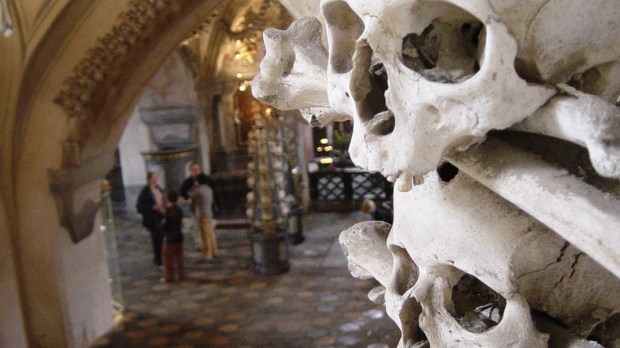With the bones of about 60,000 skeletons artistically arranged along its walls and ceilings, Sedlec Ossuary in the Czech Republic offers the visitor a none too subtle reminder that “you are dust and to dust you shall return.”
The story of how the chapel came to be adorned with its ornate display of human bones begins in 1278. Tradition has it that the abbot of the Cistercian monastery in Sedlec traveled to the Holy Land, and brought back soil taken from Golgotha, the site of Christ’s crucifixion. Word spread that he had sprinkled the cemetery grounds with the sacred dirt, and Sedlec soon became a popular burial site, attracting people from all over central Europe.
Then in the mid-14th century, the small cemetery had to expand to accommodate 30,000 victims of the Black Death. And another 10,000 bodies were buried in the cemetery as a result of the Hussite Wars, which pitted Catholics against a 15th-century Bohemian Reformation.
In about 1400, a new Gothic church was built on the Abbey grounds, and its underground chapel was used as an ossuary to store the remains displaced by the new building. Legend has it that a near-blind monk regained his eyesight after stacking the tens of thousands of exhumed bones and skulls inside and outside the church.
There the bones remained for centuries until 1784, when Austrian emperor Josef II revoked the monastery’s religious status, and the Sedlec monastery was sold to the aristocratic Schwarzenberg family, who turned it into a tobacco factory (the Philip Morris company still owns the factory, according to a post in Catholic Insight).
That’s when the Sedlec ossuary was turned into the unforgettable monument that it is today. In 1870 the Schwarzenbergs hired woodcarver František Rint to create a unique memorial to those whose remains were stacked in piles on the floor.
The result is an astounding display that attracts over 200,000 visitors a year, making it on of the most popular tourist destinations in the Czech Republic.
After bleaching the bones to a uniform whiteness, Rint created an unforgettable memento mori including a chandelier in the center of the nave that is said to contain every bone in the human body, a Schwarzenberg coat of arms made of bones, bone pyramids, monstrances, gigantic chalices and candle holders – all made of human bones.
The artist left his own mark on his work – his signature spelled out in human bones adorns the wall of Sedlec.
The chapel ossuary is open daily to the public, who are also invited to take part in a candlelit evening tour that includes a visit to the Cathedral of the Assumption of Our Lady and Saint John the Baptist, the oldest cathedral in central Europe.

